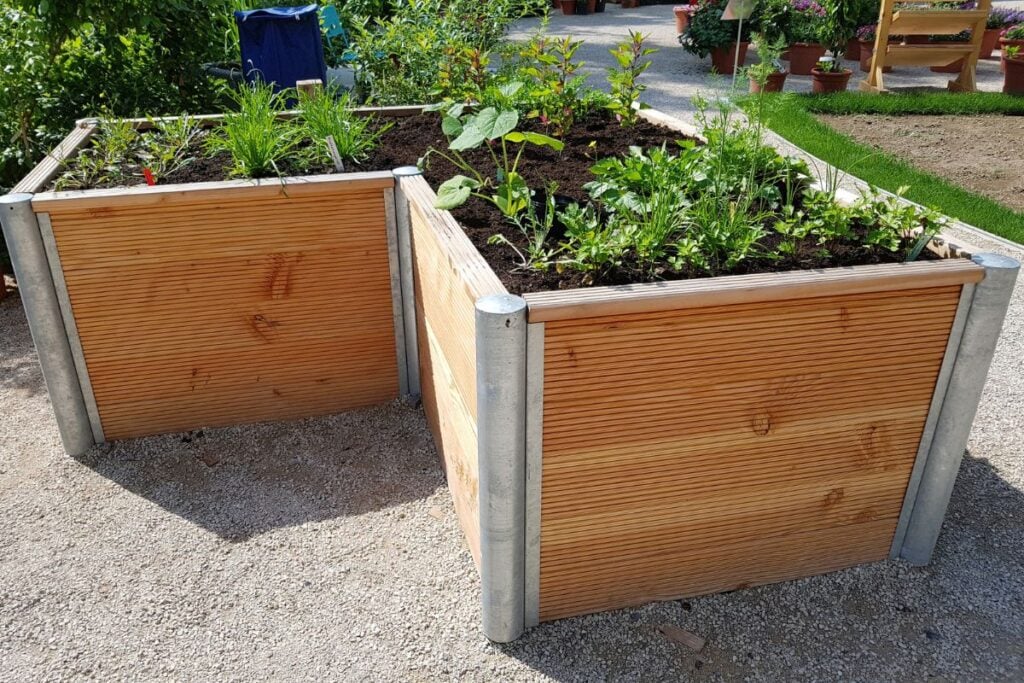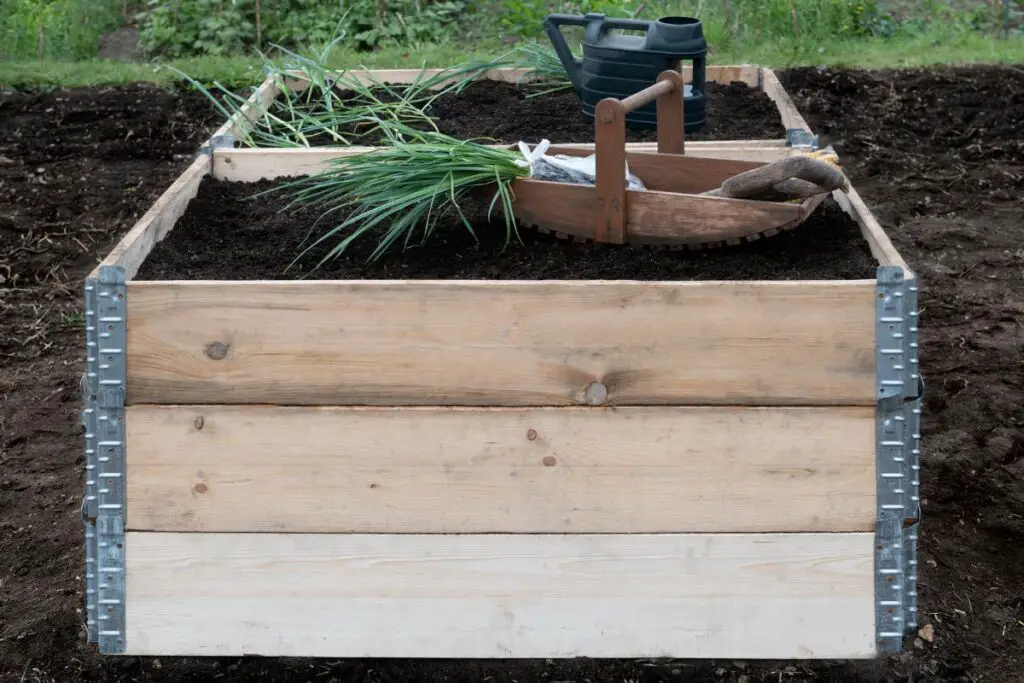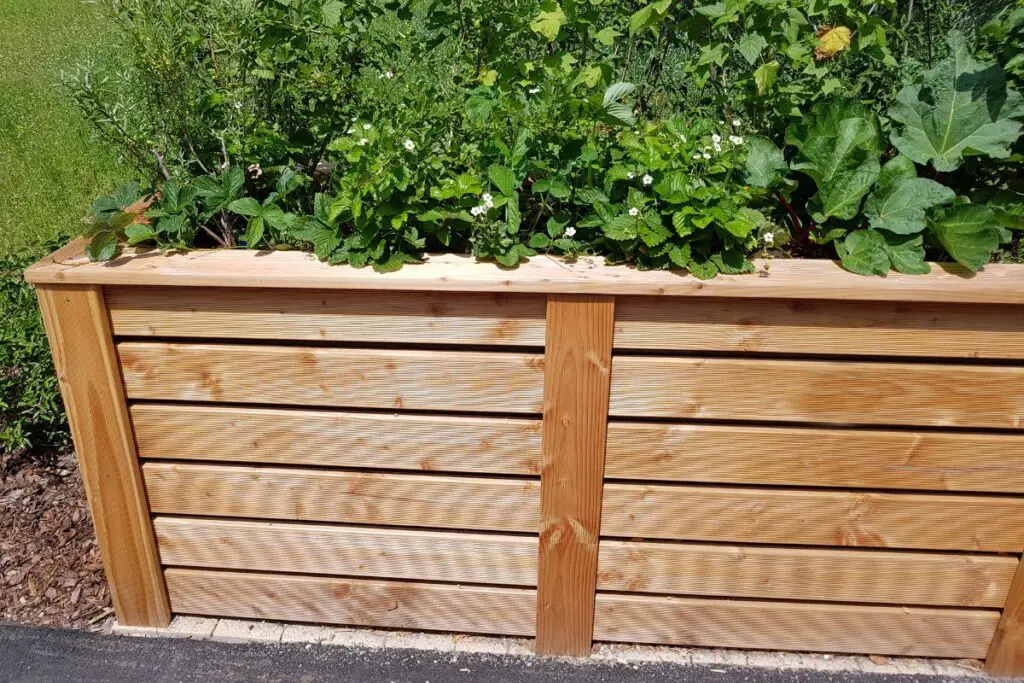Raised garden beds are popular for outdoor gardening. But, it requires effort to make a proper one that stays stable for years. Bracing is one way to hold the bed and prevent it from bowing or falling.
For bracing a garden bed, you can either brace the corners or cross brace inside the bed at the center to prevent it from bowing. The corners can be braced with metal or Insta brace brackets, and the centers can be braced with wood or rods. Mostly beds made with wood needs bracing.
Cross bracing also allows you to extend the bed and hold it in position so that the extended part doesn’t become responsible for bowing. This article will share with you the right ways of bracing the garden beds and preventing bowing or falling.

Why do garden beds need bracing?
Bracing raised beds add extra support to the bed so that they don’t bow or lean over.
It is one type of anchoring where the beds receive extra support to handle the weight of the soil.
Bracing is not required if your raised bed materials are strong enough to remain in position and hold the soil.
For example, beds made of bricks, natural stones, or masonry don’t need such braces.
They are concrete and capable of staying in the exact place.
But beds made of wood will need it.
It stops them from bending and bowing, especially if your bed is over the inclined areas.
Insta braces are used for bracing the corners of the bed.
They come in various designs, and the materials are made in a way that the wood gently sets up into the braces.
Metal brackets are more or less the same as Insta braces.
The former will need to be screwed, unlike the latter.
The next braces are the woods or rod braces used as cross bracing at the center of the wood.
It helps to hold the soil in place. You can even use it to expand your beds.
These braces will hold the extension beds and prevent them from bowing.
Also read: 16 Best Types Of Wood For Raised Garden Bed
Materials to brace the beds
You can buy Insta braces for the bed corners from the stores offline or online.
I bought mine once from the Home Depot in my area.
These braces come in metals.
You can also get timber woods as braces, but metals work better.
Coming to the cross bracings, you can use both metal and wood.
How do you brace a raised bed?
I brace my raised beds in two ways:
- Corner bracing
- Cross bracing
Looking for gardening supplies? We have tested 100's of products before recommending them to you guys. Check out our best pick below:
| Image | Gardening Supplies | Best Price? |
|---|---|---|
 Top
Top Top
Top | Raised Garden Bed Kit | Check On Amazon |
 | XLUX Soil Moisture Meter, Plant Water Monitor, Soil Hygrometer Sensor for Gardening, Farming, Indoor and Outdoor Plants, No Batteries Required | No Results |
 Top
Top Top
Top | 82 Pcs Garden Tools Set and Extra Succulent Tools Set | Check On Amazon |
 | Joeys Garden Expandable Garden Hose with 8 Function Hose Nozzle, Lightweight Anti-Kink Flexible Garden Hoses, Extra Strength Fabric with Double Latex Core, (50 FT, Black) | No Results |
 Top
Top Top
Top | Dual Chamber Compost Tumbler | Check On Amazon |
 Top
Top Top
Top | Sunnyglade Plant Stakes | Check On Amazon |
 Top
Top Top
Top | Organic Cold Pressed Neem Seed Oil | Check On Amazon |
 Top
Top Top
Top | Mighty Mint Gallon :-Insect and Pest Control Peppermint Oil | Check On Amazon |
 Top
Top Top
Top | Scotts DiseaseEx Lawn Fungicide | Check On Amazon |
 Top
Top Top
Top | Jacks Classic 20-20-20 All Purpose Fertilizer | Check On Amazon |
 Top
Top Top
Top | 30,000 Seeds Pollinator Attracting Wildflower Mixture | Check On Amazon |
 Top
Top Top
Top | Survival Vegetable Seeds Garden Kit-Over 16,000 Seeds | Check On Amazon |
Corner bracing
- MATERIAL: The bracket is made of superior stainless steel metal and The screws are made of quality iron with heat treatment to harden.
- The raised garden bed corner bracket can be applied in all different types of raised garden b
Corner bracing can be divided into two parts: Insta bracing and bracing with metals.
1. Insta corner bracing
The bracing system of the raised beds consists of four steel corner braces to be fitted at the four corners of the bed.
Settle the raised bed dimensions you want to make, and then cut your wood or lumber according to your decided sizes.
The inside of each brace will have a raised channel.
In this channel or space, you will have to slide in your cut boards or woods for the raised beds and complete four corners of the bed.
This process allows you to make your own raised beds at any place and size.
You can use the braces with 2-inch lumber or wood.
The width of the boards will determine the depth of your raised beds.
For example, if your bed is 2x4s, the depth of the bed will be 10-11 inches. If you have made 2×10 and 2×6, you will receive 14-15 inches raised bed.
Select the corner braces measuring 11 inches wide and 9 inches in height.
For corner braces, there are three measurements of boards to slip into them:
- 1×12 inch wide boards
- 2×6 inch wide boards
- 3×4 inch wide boards
One advantage of Insta bracing the corners of the raised beds is that you don’t have to use blueprints, nails, screws, or hammers to hold the beds.
Since the metal brackets are strong enough, they will hold your bed without hammering or screwing.
However, it would be best to nail the woods and set the braces.
It gives the bed extra support.
2. Bracing the corners with metal brackets
You can also brace the corners of raised beds with some metal brackets.
Metal brackets are used for anchoring the corners of the raised beds.
Unlike Insta braces, you have to create holes at the corners of the wooden beds and then fix the metal brackets with nuts or screws for support to avoid bowing.
The metal brackets have holes to get attached to the raised bed.
When you fix the metal brackets at the corners of your beds for bracing, attach them with galvanized screwing nails to fix the beds with the brackets.
Bracing like this keeps the corners of the beds firmly attached and prevents bowing or falling over.
How do you cross brace a raised bed?

Cross bracing is done to extend a raised bed or give support to the bed if it is bowing due to heavy weight.
As a rule, a bed will require bracing if it is 2 meters in length or above.
1. Cross bracing for support
The wooden or thin metal beds bow due to the heavy weight of the soil.
So, to help the beds hold the soil, I add rod braces or wooden beams to give them extra support.
A lot of people use the Birdies thin metal raised beds.
They have holes and screws, allowing you to fix braces to hold up the bed.
Birdies have their bracing materials, so they can give you the right materials and guide you about bracing.
For fixing the braces, you need an 8mm threaded rod, washers, and dome nuts.
- Open up a screw from the bed at a place where you need to fix the brace, for example, 3rd nut from top or bottom.
- Place the threaded rod in the 3rd hole of the bed from the bottom or the top, as I said, wherever your bed wants it.
- Depending on the bed size, you can double-brace your bed by placing another rod at the 6th hole.
- The rod must remain 5-8 mm out of the raised bed from both sides after fixing. It allows you to fix the washer and the dome nut.
- Now, fix the washer and the dome nut at each side of the bed and fasten it tightly.
Before considering this method, try removing some soil from where your rod will pass through.
It will make the work easier.
You can do the same thing by using a thick and strong and thick wooden beam if you have a wooden raised bed.
Remove the soil from the area where you want to fix it and then add the beam at the center and nail it.
Then keep the soil back into place.
2. Cross bracing for extended metal beds
We extend beds to increase the space and plant more plants.
You can join one extra bed with another to get longer dimensions.
You can get a long bed if you join multiple beds.
If you want an extra bed with one bed or bought multiple beds from
Birdies to daisy-chain them together; you will require bracing.
If you have the same thin metal beds from Birdies and want to add two or multiple bed pieces, the process is the same.
Birdies provide metal corners and multiple long metal pieces.
You have to join them and make a bed size of your choice.
First, position the metal pieces one after another, bring the holes of the metal pieces in one place, and then join them with nuts.
For bracing, insert the rod braces through the 3rd and 6th holes, join the threaded rods and fix them with the dome nuts and washer.
Cross bracing allows you to get a longer bed and grow multiple plants over them.
The rods will also support the bed, hold the soil, and prevent bowing.
3. Cross bracing wooden beds for longer dimensions

If you want long wooden beds for bracing:
- Take long wooden boards, screw them together, and create a long raised bed.
- Now, make 3-4 thick boards, place them vertically inside, and screw them against the bed walls. Keep proper distance between the vertically positioned woods.
- Then again, position two more boards at the top and bottom of the vertical woods horizontally with proper distance, and screw them with those woods.
Creating braces like this will give you a long bed.
You can either use the whole bed for a single plant or divide it into multiple small beds and grow different plants.
What are the other ways to prevent bowing?
Bracing the corners and centers of the beds with Insta braces, metal brackets, and cross bracing is one way of anchoring and keeping the bed from bowing.
But there are many other ways of preventing the bed from bowing, like:
- Grow beds with strong materials or make them concrete using bricks, masonry, and natural stones.
- Reduce the contact with moisture. Excessive moisture makes the soil heavy and deteriorates the wood quality. You can use wood sealers to protect the woods from water contact.
- Anchor your raised beds with metal or wooden stakes to increase their lifespan.
Final thoughts
Bracing the raised beds is beneficial in many ways. It is one type of anchoring. It keeps the bed in shape and prevents bowing. For corner bracing, you can use Insta braces where nailing and screwing are not required.
You can even use metal brackets and screw them to the bed.
You can use threaded rods with dome nuts and woods for cross bracing. Cross bracing helps extend the bed for longer dimensions and also gives extra support to the bed.
Reference: ScienceDirect, American Society of Agronomy, Noble Research Institute, Building a Raised Bed Garden, Developing design guidelines for calculating of width and height of raised bed.

